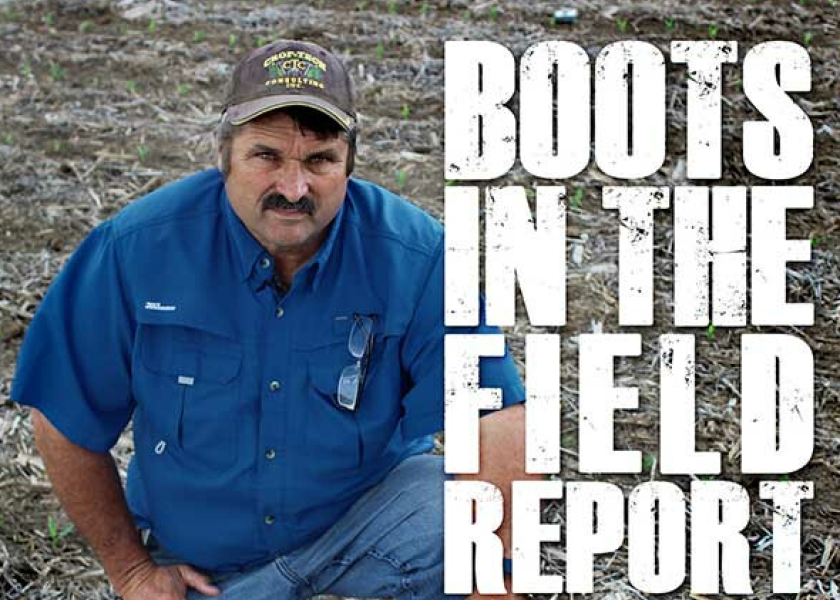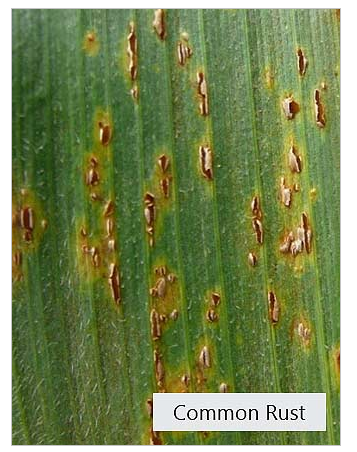Ferrie: Southern Rust is in some Illinois Corn at R4 Stage, 30 Days from Finish Line

Corn production is a marathon every season, and even though the 2021 crop in Illinois is only 30 days away from reaching the finish line it still needs to be monitored for insects and disease.
“We’re checking fields and see a big corn crop out there,” says Ken Ferrie, Farm Journal Field Agronomist. “In most cases, we have enough water to get to the finish line. We just mainly need sunshine, no smoke, moderate temperatures and then this factory can do its thing and crank out the corn.”
Disease-wise, Ferrie says his agronomic team is finding considerable gray leaf spot, northern leaf blight and common rust in corn. “With as much rain as we’ve had come through in the past week – some areas got a couple of inches, while others got up to 11” – there’s no way around that,” he says.
Of greater concern to him is the uptick in southern rust that agronomists have found in central Illinois fields during the past 10 days.
“Southern rust is nasty compared to common rust and can do a lot of damage in a hurry, so keep an eye on it and be prepared to spray a fungicide,” he advises.
To identify southern rust: look for fuzzy, raised structures (pustules) on the upper corn leaf surface and stalk. Southern rust pustules are small and round with reddish-orange spores. Rubbing a finger on pustules will reveal a reddish-orange residue.
To identify common rust: you will see it affect both upper and lower corn leaf surfaces. The pustules are brown to cinnamon-brown.
The following photos are provided courtesy of Pioneer.
Evaluate Economics
Ferrie says, in general, he has been encouraged by how well fungicide applications farmers made three weeks ago have held up against significant disease pressure. The one exception is with tar spot. It showed up in Illinois fields early this season, with Ferrie’s team first seeing it on June 30.
“I can’t tell where I sprayed and didn’t spray when it comes to tar spot and that has me baffled,” he says.
Tar spot is now above the ear on a lot of corn plants, and farmers are grappling with whether to spray.
“Given today’s corn prices, it’s a tough question to answer,” Ferrie says. “We’ve basically got 30 days left to go with this corn crop, with a lot of it at R4, and I’m not sure we’ll get our money back in this situation.”
Ferrie says he would be more enthusiastic about spraying for tar spot if fungicides had stopped it cold in its tracks earlier in the season. “I'm not convinced tar spot was slowed down with the first applications, even using the more expensive products that have it on the label. We're going to have to stay with this and think it through, as we don’t know the end of the story or how rough this will get,” he says.
Harvest Priorities
It’s not too early to begin thinking about your corn harvest priorities and which fields to combine first.
Ferrie says he is seeing fields where Physoderma brown spot has moved into the stalk rot phase.
“As you push through those fields, and you hear them snap and pop, they're breaking off right at the nodes and are pretty brittle,” he says.
“Corn that won’t pass the push test now won’t pass it 30 days from now,” he adds. “It won’t be able to withstand any windstorm and will remain brittle, even after black layer.”
There's no action farmers can take in affected fields other than to move them up to the top of their harvest schedule.
Soybean Agronomic Issues
Ferrie says as he walked bean fields this past week, he saw more sudden death syndrome (SDS) than he had in previous weeks.
“But you have to look for it; you can’t see it from the truck, but it’s out there,” he says.
He adds that white mold in some areas is getting more aggressive, and you can see it from the road. “With the moisture, I think we’ll see more of it.”
Insect-wise, Ferrie reports he is seeing bean leaf beetles in some soybean crops that are moving into R5 that need to be monitored.
The word from further north, in Iowa, Ferrie says, is that farmers there are finding spider mites in their fields, due to drier conditions.
“Hopefully you can catch them in the boundaries and the borders of fields and get yourself a little more time to pick up some moisture,” he says. “But with these bean prices, you cannot let those spider mites do much out there. Any stress that you see is going to change your bean size at this point.”
Hear Ferrie’s complete agronomic perspective on corn and soybean development in this week’s Boots In The Field report, posted below:
Ferrie: Downed Corn and Still Need to Apply N? Consider Your Options
Ferrie: 6 Ways To Harvest More Corn And Leave Less In The Field
Ferrie’s Guidance on Entering Rent Leases with Fertility Clauses
Ferrie: Fall Burndown Applications Will Still Work. Here’s How.









